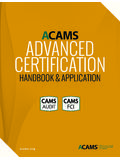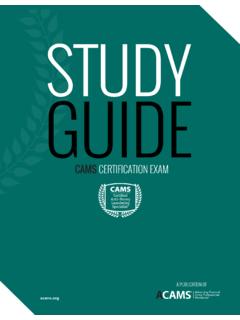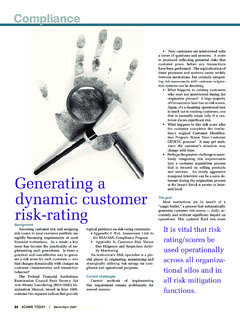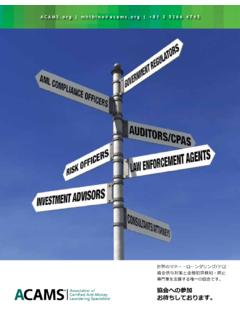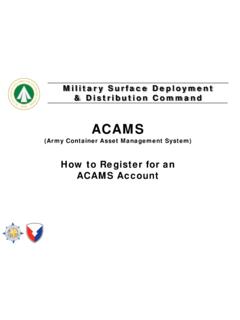Transcription of Research on Know Your Customer (KYC) - IJSRP
1 International Journal of Scientific and Research Publications, Volume 3, Issue 7, July 2013 1. ISSN 2250-3153. Research on know your Customer (KYC). Prof. Venkatesh U. Rajput , MBA., NET, JRF, Chetan Business School, Institute of Management and Research , Hubli Jurisdictions should facilitate consolidated KYC risk I. INTRODUCTION management by providing an appropriate legal A global risk management programme for KYC should incorporate consistent K now your Customer (KYC) is the due diligence and bank regulation that financial institutions and other regulated companies must perform to identify their clients and ascertain identification and monitoring of Customer accounts globally across business lines and geographical locations, as well as relevant information pertinent to doing financial business with oversight at the parent level, in order to capture instances and them.
2 In the USA, KYC is typically a policy implemented to patterns of unusual transactions that might otherwise go conform to a Customer identification program mandated under undetected. Such comprehensive treatment of Customer the Bank Secrecy Act and USA PATRIOT Act. know your information can significantly contribute to a bank's overall Customer policies are becoming increasingly important globally reputational, concentration, operational and legal risk to prevent identity theft fraud, money laundering and terrorist management through the detection of potentially harmful financing. Beyond name matching, a key aspect of KYC controls activities is to monitor transactions of a Customer against their recorded profile, history on the Customer s account(s) and with peers.
3 III. KYC ( know your Customer ) INFORMATION. FOR CUSTOMERS INTENDING TO OPEN BANK. II. KYC HAS DIFFERENT CONNOTATIONS AND THE ACCOUNT. DEFINITION ABOVE IS FROM AN AML/CFT The Reserve Bank of India (RBI) has advised banks to PERSPECTIVE follow a 'KYC guidelines', wherein certain personal information know your Customer processes are also employed by of the account-opening prospect or the Customer is obtained. The regular companies of all sizes, for the purpose of ensuring their objective of doing so is to enable the Bank to have positive proposed agents', consultants' or distributors' anti-bribery identification of its customers. This is also in the interest of compliance. Banks, insurers and export credit agencies are customers to safeguard their hard earned money.
4 The KYC. increasingly demanding that customers provide detailed anti- guidelines of RBI mandate banks to collect three proofs from corruption due diligence information, to verify their probity and their customers. They are integrity. Some specialist consultancies help multinational 1. Photograph companies and SMEs conduct know your Customer processes 2. Proof of identity when entering new markets. The consultative paper 3. Proof of address 'Consolidated know - your - Customer (KYC) risk management' is a supplement to the Basel Committee's ' Customer due diligence for banks' issued in October 2001. It examines the critical elements IV. know your Customer WHAT YOU MUST. for effective management of KYC policies and procedures in know .
5 Banks' foreign branches and subsidiaries. What is KYC? The adoption of effective know - your - Customer (KYC) know your Customer - KYC enables banks to know /. standards is an essential part of banks' risk management understand their customers and their financial dealings to be able practices. As discussed in the Customer due diligence for banks to serve them better (CDD) paper, banks with inadequate KYC standards may be subject to significant risks, especially legal and reputational risk. Who is a Customer of the Bank? Sound KYC policies and procedures not only contribute to a For the purpose of KYC Policy, a Customer is defined as: bank's overall safety and soundness, they also protect the 1) A person or entity that maintains an account and/or has integrity of the banking system by reducing the likelihood of a business relationship with the Bank.
6 Banks becoming vehicles for money laundering, terrorist 2) One on whose behalf the account is maintained ( the financing and other unlawful activities. beneficial owner);. The CDD paper outlines four essential elements necessary for a sound KYC programme. These elements are V. ENHANCED DUE DILIGENCE. 1. Customer acceptance policy EDD has not been internationally defined. As a result 2. Customer identification financial institutions are at risk of being held to differing 3. On-going monitoring of higher risk accounts standards dependent upon their jurisdiction and regulatory environment. An article published by Peter Warrack in the July International Journal of Scientific and Research Publications, Volume 3, Issue 7, July 2013 2.
7 ISSN 2250-3153. 2006 edition of acams Today (Association of Certified Anti- from staff that believed they were experienced, but in practice Money Laundering Specialists) suggests the following: were not and consequently failed to find relevant information. A rigorous and robust process of investigation over and above (KYC) procedures, that seeks with reasonable assurance to KYC Process Capability Maturity Model verify and validate the Customer s identity; understand and test A draft KYC Capability Maturity Model was published and the Customer s profile, business and account activity; identify shared with a range of international KYC practitioners in 2009. relevant adverse information and risk assess the potential for and 2010.
8 An updated and peer-reviewed version will be money laundering and / or terrorist financing to support published in the acams acams Today magazine in early actionable decisions to mitigate against financial, regulatory and 2011. reputational risk and ensure regulatory compliance. The KYC Maturity Model is based on the typical 5 levels of the standard Capability Maturity Model. These levels are typically described as Initial, Repeatable, Defined, Managed and VI. CHARACTERISTICS OF EDD Optimized and have very strict meanings. The KYC maturity has 1. Rigorous and robust however been somewhat simplified, renamed and re-built as Generally this means consistent, thorough and accurate. The follows: Chaotic, Reactive, Proactive, Service Managed and process must be documented and available for inspection by Value Managed.
9 Practical process improvement learning s have regulators. The process must be SMART (Specific, Measurable, also been taken from common manufacturing and IT productivity Achievable, Relevant and Time bound), scalable and methodologies such as Lean, Agile, 6-Sigma, ITIL and Balanced proportionate to the risk and resources. A Ball workflow system Scorecard. ensuring that the KYC process and procedures are Defined, Repeatable and Measurable is recommended. 2. Reasonable assurance VIII. CONTINUOUS DUE DILIGENCE. What is reasonable depends upon factors including CDD refers to the monitoring of clients and their activities to jurisdiction, risk and resources. For sanction matches it depends see if the client does not change markedly over time.
10 In effect upon information provided by regulators. In all cases the this combats the possibility that an individual (or more often an suggested standard is to the civil standard of proof on the organization) that has passed KYC is still who they say they are balance of probability. and doing what they said they would do when they underwent 3. Relevant adverse information KYC checks. For example a corporate account set up honestly Information obtained from any source, including the and openly by one person who passes KYC checks could be Internet, free and subscription databases and the media, which is passed years later to another person that would not, without CDD. directly or indirectly indicative of involvement in money the services provider would not know that the new owner is laundering, terrorist financing or predicate offenses.










